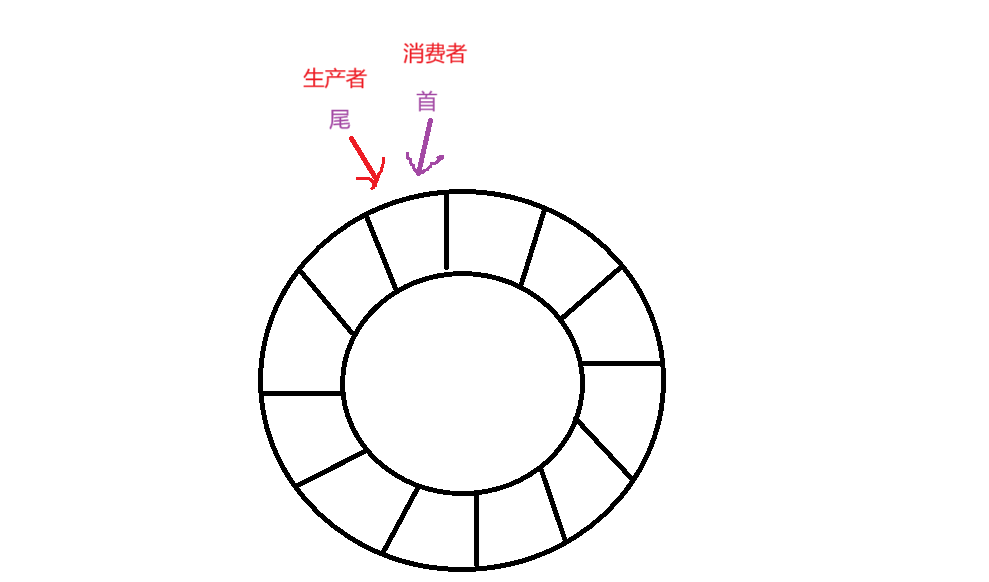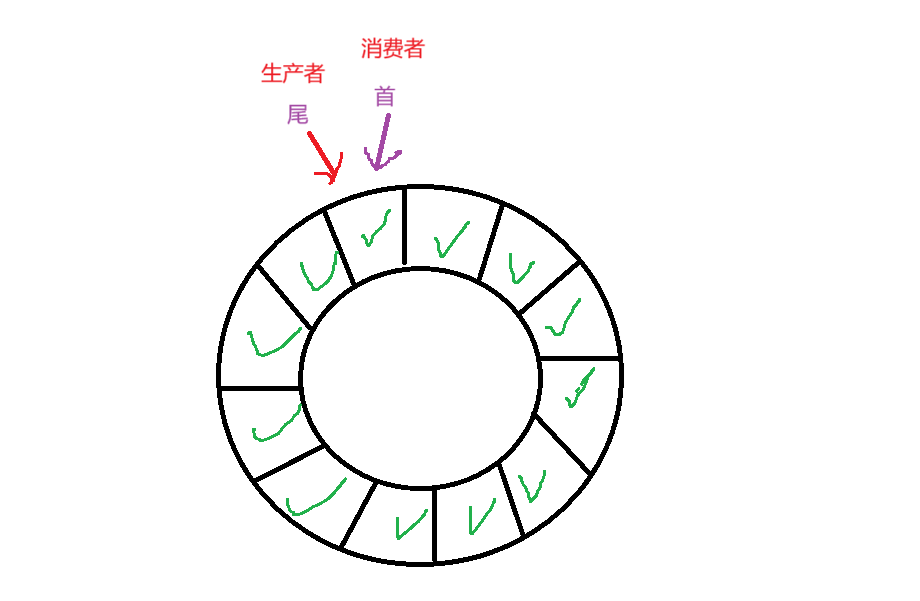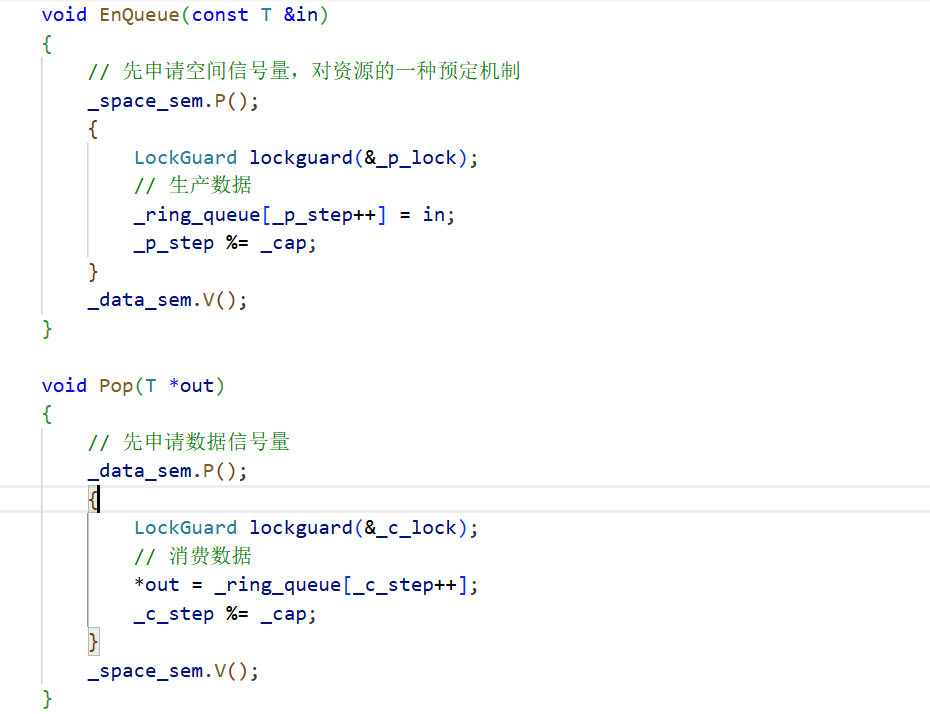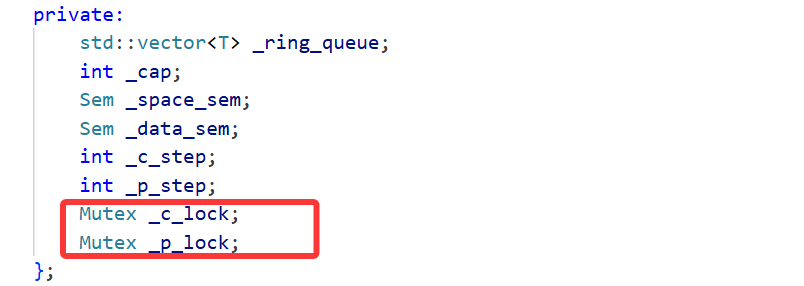一、信号量
关于信号量的介绍在深入Linux内核:IPC资源管理揭秘这篇文章当中已经做了初步的介绍了,相信大家对于信号量已经有了初步的认知了。
今天,我们就来探讨如何实现信号量。
1. 信号量的接口
//初始化信号量
//成功了,返回0,失败了,返回-1并且设置错误码
//sem初始化的信号量
//pshared设置为0,代表线程间使用
//value信号量的初始值
int sem_init(sem_t* sem, int pshared, unsigned int value);
//销毁信号量
//成功返回0,失败返回-1并且设置错误码
int sem_destroy(sem_t* sem);
//减少信号量
//成功返回0,失败返回-1并且设置错误码
int sem_wait(sem_t* sem);
//增加信号量
//成功返回0,失败返回-1并且设置错误码
int sem_post(sem_t* sem);2. 信号量实现的一些细节问题
信号量的接口就了解到这里。我们实现的信号量是基于一个环形队列实现的(数组)。
接下来,我们了解实现的一些细节。

队列的容量是有限的,刚开始时,队列为空,一定是生产者先运行。此时生产者和消费者访问同一个位置,生产者还没生产数据,消费者就开始消费数据,这是不行的,所以,必须等到生产者生产数据之后,消费者才可以消费数据。所以,生产者和消费者之间需要维护互斥与同步的关系。

当队列为满时,必须让消费者先运行。此时生产者,消费者又指向了同一个位置,当消费者拿取数据时,生产者是不能立即生产数据的,要不然消费者还没有获取到数据,生产者已经把数据覆盖了,不就导致数据错乱了吗!所以,这个过程不仅需要生产者和消费者互斥的获取数据,还需要同步。
当队列不为空,不为满时,生产者和消费者肯定不是指向同一个位置的,所以,生产者和消费者不就可以并发执行了。
3. 信号量的实现
Sem.hpp
c
#pragma once
#include<iostream>
#include<vector>
#include<unistd.h>
#include<semaphore.h>
class Sem
{
public:
Sem(int num)
:_initnum(num)
{
sem_init(&_sem, 0, _initnum);
}
void P()
{
int n = sem_wait(&_sem);
}
void V()
{
int n = sem_post(&_sem);
}
~Sem()
{
sem_destroy(&_sem);
}
private:
sem_t _sem;
int _initnum;
};RingQueue.hpp
c
#include"Sem.hpp"
int gcap = 5;
template<typename T>
class RingQueue
{
public:
RingQueue(int cap = gcap):_ring_queue(cap),_cap(cap),_space_sem(cap),_data_sem(0)
,_c_step(0),_p_step(0)
{
}
void EnQueue(const T& in)
{
//先申请空间信号量,对资源的一种预定机制
_space_sem.P();
//生产数据
_ring_queue[_p_step++] = in;
_p_step %= _cap;
_data_sem.V();
}
void Pop(T* out)
{
//先申请数据信号量
_data_sem.P();
//消费数据
*out = _ring_queue[_c_step++];
_c_step %= _cap;
_space_sem.V();
}
~RingQueue()
{}
private:
std::vector<T> _ring_queue;
int _cap;
Sem _space_sem;
Sem _data_sem;
int _c_step;
int _p_step;
};main.cc
c
#include"RingQueue.hpp"
void* consumer(void* args)
{
RingQueue<int>* rq = static_cast<RingQueue<int>*>(args);
while(true)
{
int data = 0;
rq->Pop(&data);
std::cout << "消费者消费了一个数据" << data << std::endl;
}
}
void* productor(void* args)
{
RingQueue<int>* rq = static_cast<RingQueue<int>*>(args);
int data = 1;
while(true)
{
sleep(1);
rq->EnQueue(data);
std::cout << "生产者生产了一个数据" << data << std::endl;
data++;
}
}
int main()
{
RingQueue<int>* rq = new RingQueue<int>();
pthread_t c, p;
pthread_create(&c, nullptr, consumer, (void*)rq);
pthread_create(&p, nullptr, productor, (void*)rq);
pthread_join(c, nullptr);
pthread_join(p, nullptr);
return 0;
}Makefile
c
ringqueue:main.cc
g++ -o $@ $^ -std=c++11
.PHONY:clean
clean:
rm -f ringqueue4. 信号量实现过程中的一些疑问
这是一个基于单生产者,单消费者的信号量。
问题1:我们在申请信号量的过程当中并没有用到锁,难道就不怕数据不安全吗?
刚开始时,队列为空,生产者先申请信号量,生产数据,然后在V操作,唤醒消费者,消费者才能消费数据。这个过程本身就已经完成了生产者和消费者之间的互斥与同步关系。
当队列为满时,生产者申请信号量失败,就被阻塞住,此时消费者申请信号量,消费数据,然后再唤醒生产者,生产者才能生产数据,所以这个过程本身也完成了生产者与消费者之间的互斥与同步关系。
而队列不为空也不为满时,生产者和消费者可以并发执行。
问题2:我们怎么没有在临界区内部,判断资源是否就绪呢?
信号量本身就是一把计数器,是对于资源的一种预定机制,对信号量进行P操作的时候,虽然是申请信号量,但本质就是对资源是否就绪进行判断。有多少资源就可以预定多少资源,绝不会预定出的资源比实际资源多,也就是说有多少资源就可以有多少个生产者线程。
重新理解信号量。
我们把信号量设置为5,如果信号量设置为1呢?不就是二元信号量 ,一个线程申请信号量之后就不可能再有第二个线程成功申请信号量,信号量就变为了0 ,这不就是一把锁吗!控制着线程的开关。
重新理解一下锁:不就是认为自己的资源只有一份,申请锁不就类似于二元信号量,信号量P操作,释放锁不就是V操作。
所以,锁是信号量的一种特殊情况。



二、日志与策略模式
什么是日志呢?
计算机中的日志是记录系统和软件运行中发生事件的文件,主要作用是监控运行状态,记录异常信息,帮助快速定位问题并支持程序员进行问题修复,它是系统维护,故障排查和安全管理的重要工具。
我们设计的日志格式主要包含以下几个指标:
时间戳、日志等级、日志内容、文件名、行号,进程线程相关 id 信息。
//获取时间戳
//tloc设置为nullptr
time_t time(time_t* tloc);
//timep获取到的时间戳
//result输出型参数
struct tm* localtime_r(const time_t* timep, struct tm* result);
c
struct tm
{
int tm_sec; /* Seconds (0-60) */
int tm_min; /* Minutes (0-59) */
int tm_hour; /* Hours (0-23) */
int tm_mday; /* Day of the month (1-31) */
int tm_mon; /* Month (0-11) */
int tm_year; /* Year - 1900 */
int tm_wday; /* Day of the week (0-6, Sunday = 0) */
int tm_yday; /* Day in the year (0-365, 1 Jan = 0) */
int tm_isdst; /* Daylight saving time */
};Logger.hpp
c
#pragma once
#include <iostream>
#include <filesystem>
#include <fstream>
#include <string>
#include <sstream>
#include <memory>
#include <unistd.h>
#include "Mutex.hpp"
enum class LoggerLevel
{
DEBUG,
INFO,
WARNING,
ERROR,
FATAL
};
std::string LoggerLevelToString(LoggerLevel level)
{
switch (level)
{
case LoggerLevel::DEBUG:
return "Debug";
case LoggerLevel::INFO:
return "Info";
case LoggerLevel::WARNING:
return "Warning";
case LoggerLevel::ERROR:
return "Error";
case LoggerLevel::FATAL:
return "Fatal";
default:
return "Unknown";
}
}
std::string GetCurrentTime()
{
// 获取时间戳
time_t timep = time(nullptr);
// 把时间戳转化为时间格式
struct tm currtm;
localtime_r(&timep, &currtm);
// 转化为字符串
char buffer[64];
snprintf(buffer, sizeof(buffer), "%4d-%02d-%02d %02d-%02d-%02d",
currtm.tm_year + 1900, currtm.tm_mon + 1, currtm.tm_mday,
currtm.tm_hour, currtm.tm_min, currtm.tm_sec);
return buffer;
}
class LogStrategy
{
public:
virtual ~LogStrategy() = default;
virtual void SyncLog(const std::string &logmessage) = 0;
};
// 显示器刷新
class ConsoleLogStrategy : public LogStrategy
{
public:
~ConsoleLogStrategy()
{
}
virtual void SyncLog(const std::string &logmessage) override
{
{
LockGuard lockguard(&_lock);
std::cout << logmessage << std::endl;
}
}
private:
Mutex _lock;
};
const std::string default_dir_path_name = "log";
const std::string default_filename = "test.log";
// 文件刷新
class FileLogStrategy : public LogStrategy
{
public:
FileLogStrategy(const std::string dir_path_name = default_dir_path_name,
const std::string filename = default_filename)
: _dir_path_name(dir_path_name), _filename(filename)
{
if (std::filesystem::exists(_dir_path_name))
{
return;
}
try
{
std::filesystem::create_directories(_dir_path_name);
}
catch (const std::filesystem::filesystem_error &e)
{
std::cerr << e.what() << "\r\n";
}
}
~FileLogStrategy()
{
}
virtual void SyncLog(const std::string &logmessage) override
{
{
LockGuard lock(&_lock);
std::string target = _dir_path_name;
target += '/';
target += _filename;
std::ofstream out(target.c_str(), std::ios::app);
if (!out.is_open())
{
return;
}
out << logmessage << "\n";
out.close();
}
}
private:
std::string _dir_path_name;
std::string _filename;
Mutex _lock;
};
class Logger
{
public:
Logger()
{
}
void EnableConsoleStrategy()
{
_strategy = std::make_unique<ConsoleLogStrategy>();
}
void EnableFileStrategy()
{
_strategy = std::make_unique<FileLogStrategy>();
}
class LogMessage
{
public:
LogMessage(LoggerLevel level, std::string filename, int line, Logger& logger)
: _curr_time(GetCurrentTime()), _level(level), _pid(getpid())
, _filename(filename), _line(line), _logger(logger)
{
std::stringstream ss;
ss << "[" << _curr_time << "] "
<< "[" << LoggerLevelToString(_level) << "] "
<< "[" << _pid << "] "
<< "[" << _filename << "] "
<< "[" << _line << "]"
<< " - ";
_loginfo = ss.str();
}
template <typename T>
LogMessage &operator<<(const T &info)
{
std::stringstream ss;
ss << info;
_loginfo += ss.str();
return *this;
}
~LogMessage()
{
if (_logger._strategy)
{
_logger._strategy->SyncLog(_loginfo);
}
}
private:
std::string _curr_time; // 时间戳
LoggerLevel _level; // 日志等级
pid_t _pid; // 进程pid
std::string _filename; // 文件名
int _line; // 行号
std::string _loginfo; // 一条合并完成的,完整的日志信息
Logger &_logger; // 提供刷新策略的具体做法
};
LogMessage operator()(LoggerLevel level, std::string filename, int line)
{
return LogMessage(level, filename, line, *this);
}
~Logger()
{
}
private:
std::unique_ptr<LogStrategy> _strategy;
};
Logger logger;
#define LOG(level) logger(level, __FILE__, __LINE__)
#define EnableConsoleStrategy() logger.EnableConsoleStrategy()
#define EnableFileStrategy() logger.EnableFileStrategy()Mutex.hpp
c
#pragma once
#include<iostream>
#include<mutex>
#include<pthread.h>
class Mutex
{
public:
Mutex()
{
pthread_mutex_init(&_lock, nullptr);
}
void Lock()
{
pthread_mutex_lock(&_lock);
}
void Unlock()
{
pthread_mutex_unlock(&_lock);
}
~Mutex()
{
pthread_mutex_destroy(&_lock);
}
private:
pthread_mutex_t _lock;
};
class LockGuard
{
public:
LockGuard(Mutex* _mutex)
:_mutexp(_mutex)
{
_mutexp->Lock();
}
~LockGuard()
{
_mutexp->Unlock();
}
private:
Mutex* _mutexp;
};main.cc
c
#include"Logger.hpp"
int main()
{
EnableConsoleStrategy();
LOG(LoggerLevel::ERROR) << "hello linux" << ", 6.66 " << 123;
LOG(LoggerLevel::WARNING) << "hello linux" << ", 6.66 " << 123;
LOG(LoggerLevel::ERROR) << "hello linux" << ", 6.66 " << 123;
LOG(LoggerLevel::ERROR) << "hello linux" << ", 6.66 " << 123;
LOG(LoggerLevel::ERROR) << "hello linux" << ", 6.66 " << 123;
// std::string test = "hello world, hello log";
// std::unique_ptr<LogStrategy> logger_ptr = std::make_unique<ConsoleLogStrategy>();
// // logger_ptr->SyncLog(test);
// // std::unique_ptr<LogStrategy> logger_ptr = std::make_unique<FileLogStrategy>();
// logger_ptr->SyncLog(GetCurrentTime());
// sleep(1);
// logger_ptr->SyncLog(GetCurrentTime());
// sleep(1);
// logger_ptr->SyncLog(GetCurrentTime());
// sleep(1);
// logger_ptr->SyncLog(GetCurrentTime());
// sleep(1);
// logger_ptr->SyncLog(GetCurrentTime());
return 0;
}Makefile
c
logger_test:main.cc
g++ -o $@ $^ -std=c++17 -lpthread
.PHONY:clean
clean:
rm -f logger_test这里的构思非常的巧妙,本来想要输出一条完整的日志信息,需要很复杂的操作,现在利用这样的做法就可以用一行代码输出一条完整的日志信息。
下面我们就来看看是怎样的做法呢?

我们在外部类 Logger 里重载了运算符(),返回了一个 LogMessage 类的临时对象。



EnableConsoleStrategy();这个其实就是一个宏,这个宏是对于 Logger 类里面的两个函数的简便操作,LOG也是一个宏,是对于()运算符的重载函数的简便操作。

所以,当调用了LOG宏之后会返回一个临时对象,<<运算符重载函数是LogMessage类的一个成员函数,返回的是临时对象的引用,因为,LOG宏返回一个LogMessage类的临时对象,这个临时对象又继续调用了 << 运算符函数,继续返回临时对象的引用,以此类推,直到调用结束。
临时对象是具有常性的,它的生命周期在一条语句之后结束,所以可以返回临时对象的引用。
今天的文章分享到此结束,觉得不错的伙伴给个一键三连吧。